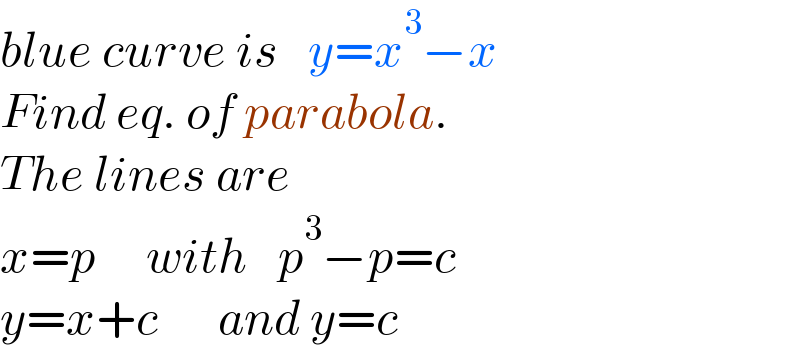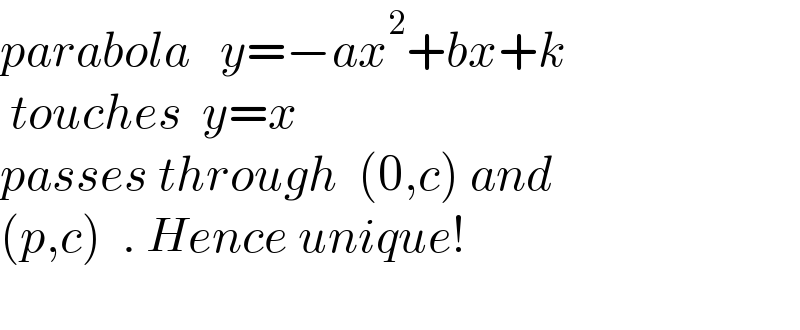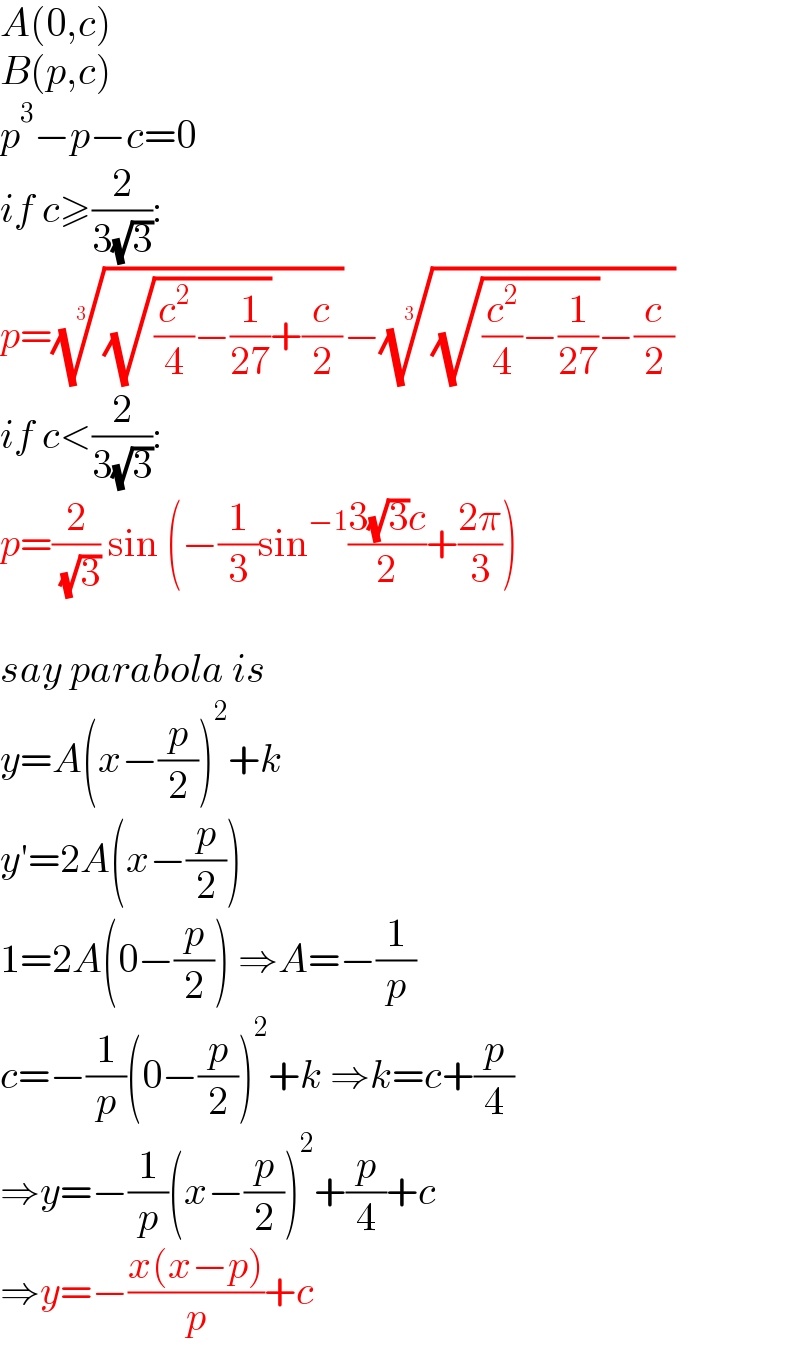
Question Number 157712 by ajfour last updated on 26/Oct/21

Commented by ajfour last updated on 26/Oct/21

$${blue}\:{curve}\:{is}\:\:\:{y}={x}^{\mathrm{3}} −{x} \\ $$$${Find}\:{eq}.\:{of}\:{parabola}. \\ $$$${The}\:{lines}\:{are} \\ $$$${x}={p}\:\:\:\:\:{with}\:\:\:{p}^{\mathrm{3}} −{p}={c} \\ $$$${y}={x}+{c}\:\:\:\:\:\:{and}\:{y}={c} \\ $$
Commented by ajfour last updated on 26/Oct/21

$${parabola}\:\:\:{y}=−{ax}^{\mathrm{2}} +{bx}+{k} \\ $$$$\:{touches}\:\:{y}={x} \\ $$$${passes}\:{through}\:\:\left(\mathrm{0},{c}\right)\:{and} \\ $$$$\left({p},{c}\right)\:\:.\:{Hence}\:{unique}! \\ $$$$ \\ $$
Answered by ajfour last updated on 26/Oct/21

$${y}={c}+{q}^{\mathrm{2}} −{A}\left({x}−{q}\right)^{\mathrm{2}} \\ $$$${and}\:\:{p}=\mathrm{2}{q} \\ $$$${so}\:\:\mathrm{8}{q}^{\mathrm{3}} =\mathrm{2}{q}+{c} \\ $$$${x}+{c}={c}−{Ax}^{\mathrm{2}} +\mathrm{2}{Aqx}+\left(\mathrm{1}−{A}\right){q}^{\mathrm{2}} \\ $$$${Ax}^{\mathrm{2}} +\left(\mathrm{2}{Aq}−\mathrm{1}\right){x}+\left(\mathrm{1}−{A}\right){q}^{\mathrm{2}} =\mathrm{0} \\ $$$${touches}\:{y}={x}+{c}\:{hence} \\ $$$$\left(\mathrm{2}{Aq}−\mathrm{1}\right)^{\mathrm{2}} =\mathrm{4}\left(\mathrm{1}−{A}\right){q}^{\mathrm{2}} \:\:...\left({i}\right) \\ $$$$\& \\ $$$$\:\:\:\mathrm{8}{q}^{\mathrm{3}} =\mathrm{2}{q}+{c}\:\:\:\:...\left({ii}\right) \\ $$$${let}\:\:\:{q}={s}+{t} \\ $$$$\left(\mathrm{2}{As}+\mathrm{2}{At}−\mathrm{1}\right)^{\mathrm{2}} =\mathrm{4}\left(\mathrm{1}−{A}\right)\left({s}+{t}\right)^{\mathrm{2}} \\ $$$${if}\:\:\:\mathrm{2}{At}+\mathrm{2}{As}−\mathrm{1}={m}\left({s}+{t}\right) \\ $$$$\Rightarrow\:\:\:{s}+{t}=\frac{\mathrm{1}}{\mathrm{2}{A}−{m}} \\ $$$$\&\:\:\:\:{m}^{\mathrm{2}} =\mathrm{4}\left(\mathrm{1}−{A}\right) \\ $$$$\Rightarrow\:\:{A}=\mathrm{1}−\frac{{m}^{\mathrm{2}} }{\mathrm{4}} \\ $$$$\frac{\mathrm{8}}{\left(\mathrm{2}{A}−{m}\right)^{\mathrm{3}} }=\frac{\mathrm{2}}{\left(\mathrm{2}{A}−{m}\right)}+{c} \\ $$$$\frac{\mathrm{8}}{\left(\mathrm{2}−\frac{{m}^{\mathrm{2}} }{\mathrm{2}}−{m}\right)^{\mathrm{3}} }=\frac{\mathrm{2}}{\left(\mathrm{2}−\frac{{m}^{\mathrm{2}} }{\mathrm{2}}−{m}\right)}+{c} \\ $$$$\mathrm{8}=\left(\mathrm{2}−\frac{{m}^{\mathrm{2}} }{\mathrm{2}}−{m}\right)^{\mathrm{2}} +{c}\left(\mathrm{2}−\frac{{m}^{\mathrm{2}} }{\mathrm{2}}−{m}\right)^{\mathrm{3}} \\ $$$${let}\:\:\:{m}=\mathrm{2}{k} \\ $$$$\mathrm{2}=\left(\mathrm{1}−{k}^{\mathrm{2}} −{k}\right)^{\mathrm{2}} +\mathrm{2}{c}\left(\mathrm{1}−{k}^{\mathrm{2}} −{k}\right)^{\mathrm{3}} \\ $$$$\mathrm{2}=\left\{\frac{\mathrm{5}}{\mathrm{4}}−\left({k}−\frac{\mathrm{1}}{\mathrm{2}}\right)^{\mathrm{2}} \right\}^{\mathrm{2}} +\mathrm{2}{c}\left\{\frac{\mathrm{5}}{\mathrm{4}}−\left({k}−\frac{\mathrm{1}}{\mathrm{2}}\right)^{\mathrm{2}} \right\}^{\mathrm{3}} \\ $$$${let}\:\:\left({k}−\frac{\mathrm{1}}{\mathrm{2}}\right)^{\mathrm{2}} =\lambda \\ $$$$\mathrm{2}=\frac{\mathrm{25}}{\mathrm{16}}−\frac{\mathrm{5}\lambda}{\mathrm{2}}+\lambda^{\mathrm{2}} +\mathrm{2}{c}\left(\frac{\mathrm{125}}{\mathrm{64}}−\lambda^{\mathrm{3}} −\frac{\mathrm{15}\lambda^{\mathrm{2}} }{\mathrm{4}}+\frac{\mathrm{75}\lambda}{\mathrm{16}}\right) \\ $$$$\mathrm{2}{c}\lambda^{\mathrm{3}} +\left(\frac{\mathrm{15}{c}}{\mathrm{2}}−\mathrm{1}\right)\lambda^{\mathrm{2}} +\left(\frac{\mathrm{5}}{\mathrm{2}}−\frac{\mathrm{75}{c}}{\mathrm{8}}\right)\lambda \\ $$$$+\frac{\mathrm{28}−\mathrm{250}{c}}{\mathrm{64}}=\mathrm{0} \\ $$
Answered by mr W last updated on 27/Oct/21

Commented by mr W last updated on 27/Oct/21

$${A}\left(\mathrm{0},{c}\right) \\ $$$${B}\left({p},{c}\right) \\ $$$${p}^{\mathrm{3}} −{p}−{c}=\mathrm{0} \\ $$$${if}\:{c}\geqslant\frac{\mathrm{2}}{\mathrm{3}\sqrt{\mathrm{3}}}: \\ $$$${p}=\sqrt[{\mathrm{3}}]{\sqrt{\frac{{c}^{\mathrm{2}} }{\mathrm{4}}−\frac{\mathrm{1}}{\mathrm{27}}}+\frac{{c}}{\mathrm{2}}}−\sqrt[{\mathrm{3}}]{\sqrt{\frac{{c}^{\mathrm{2}} }{\mathrm{4}}−\frac{\mathrm{1}}{\mathrm{27}}}−\frac{{c}}{\mathrm{2}}} \\ $$$${if}\:{c}<\frac{\mathrm{2}}{\mathrm{3}\sqrt{\mathrm{3}}}: \\ $$$${p}=\frac{\mathrm{2}}{\:\sqrt{\mathrm{3}}}\:\mathrm{sin}\:\left(−\frac{\mathrm{1}}{\mathrm{3}}\mathrm{sin}^{−\mathrm{1}} \frac{\mathrm{3}\sqrt{\mathrm{3}}{c}}{\mathrm{2}}+\frac{\mathrm{2}\pi}{\mathrm{3}}\right) \\ $$$$ \\ $$$${say}\:{parabola}\:{is} \\ $$$${y}={A}\left({x}−\frac{{p}}{\mathrm{2}}\right)^{\mathrm{2}} +{k} \\ $$$${y}'=\mathrm{2}{A}\left({x}−\frac{{p}}{\mathrm{2}}\right) \\ $$$$\mathrm{1}=\mathrm{2}{A}\left(\mathrm{0}−\frac{{p}}{\mathrm{2}}\right)\:\Rightarrow{A}=−\frac{\mathrm{1}}{{p}} \\ $$$${c}=−\frac{\mathrm{1}}{{p}}\left(\mathrm{0}−\frac{{p}}{\mathrm{2}}\right)^{\mathrm{2}} +{k}\:\Rightarrow{k}={c}+\frac{{p}}{\mathrm{4}} \\ $$$$\Rightarrow{y}=−\frac{\mathrm{1}}{{p}}\left({x}−\frac{{p}}{\mathrm{2}}\right)^{\mathrm{2}} +\frac{{p}}{\mathrm{4}}+{c} \\ $$$$\Rightarrow{y}=−\frac{{x}\left({x}−{p}\right)}{{p}}+{c} \\ $$
Commented by mr W last updated on 27/Oct/21

Commented by mr W last updated on 27/Oct/21

Commented by ajfour last updated on 27/Oct/21

$${thank}\:{you}\:{sir}!\: \\ $$
Commented by Ahmed1hamouda last updated on 29/Oct/21

$$\mathrm{What}\:\mathrm{applications}\:\mathrm{do}\:\mathrm{you}\:\mathrm{use}\:\mathrm{in}\:\mathrm{thee} \\ $$$$\mathrm{enginering}\:\mathrm{solution} \\ $$
Commented by mr W last updated on 29/Oct/21

$${Grapher} \\ $$
